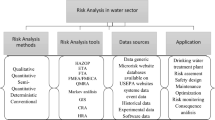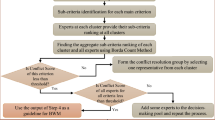Abstract
Healthcare services provided by hospitals and clinics inevitably produce waste that may hazardous to the environment and society. However, there is a lack of an effective and comprehensive evaluation framework that takes uncertainty and fuzziness into account to assess healthcare waste treatment technologies in the emerging economies. The objective of this paper is to present a new integrated multi-criteria decision-making method based on interval-valued fuzzy DEMATEL (Decision-Making Trial and Evaluation Laboratory) and interval-valued fuzzy TOPSIS for evaluating healthcare waste treatment technologies in the emerging economies from a sustainability perspective. In this study, the decision makers are allowed to determine the weights of the evaluation criteria and prioritize the alternatives using linguistic variables. The weights of the evaluation criteria are determined by the interval-valued fuzzy DEMATEL method, and the prioritization of the alternatives is determined by the interval-valued fuzzy TOPSIS (Technique for Order Preference by Similarity to an Ideal Solution) method. Four alternatives for healthcare waste treatment technologies including incineration, steam sterilization, microwave and landfill are studied, and the results show that our established method is effective to help the decision-makers to determine the prioritization of the alternatives for healthcare waste treatment technologies.


Similar content being viewed by others
References
Aghajani Mir M, Taherei Ghazvinei P, Sulaiman NMN, Basri NEA, Saheri S, Mahmood NZ, Jahan A, Begum RA, Aghamohammadi N (2016) Application of TOPSIS and VIKOR improved versions in a multi criteria decision analysis to develop an optimized municipal solid waste management model. J Environ Manage 166:109–115. https://doi.org/10.1016/j.jenvman.2015.09.028
Thakur V, Vikas A (2015) Healthcare waste management research: a structured analysis and review (2005–2014). Waste Manage Res 33:855–870. https://doi.org/10.1177/0734242X15594248
Shwesin AT, Luan S, Xu Q (2019) Application of multi-criteria-decision approach for the analysis of medical waste management systems in Myanmar. J Clean Prod 222:733–745. https://doi.org/10.1016/j.jclepro.2019.03.049
Taghipour H, Mosaferi M (2009) Characterization of medical waste from hospitals in Tabriz. Iran. Sci Total Environ 407(5):1527–1535. https://doi.org/10.1016/j.scitotenv.2008.11.032
Lee S, Vaccari M, Tudor T (2016) Considerations for choosing appropriate healthcare waste management treatment technologies: a case study from an East Midlands NHS Trust, in England. J Clean Prod 165:139–147. https://doi.org/10.1016/j.jclepro.2016.05.166
Manga VE, Forton OT, Mofor LA, Woodard R (2011) Health care waste management in Cameroon: a case study from the Southwestern Region. Resour Conserv Recycl 57:108–116. https://doi.org/10.1016/j.resconrec.2011.10.002
Mbongwe B, Mmereki BT, Magashula A (2008) Healthcare waste management: current practices in selected healthcare facilities, Botswana. Waste Manage 28(1):226–233. https://doi.org/10.1016/j.wasman.2006.12.019
Windfeld ES, Brooks MS (2015) Medical waste management—a review. J Environ Manage 163:98–108. https://doi.org/10.1016/j.jenvman.2015.08.013
Brent AC, Rogers DEC, Ramabitsa-Siimane TSM, Rohwer MB (2007) Application of the analytical hierarchy process to establish health care waste management systems that minimise infection risks in developing countries. Eur J Oper Res 181(1):403–424. https://doi.org/10.1016/j.ejor.2006.06.015
Su EC, Chen Y (2018) Policy or income to affect the generation of medical wastes: an application of environmental Kuznets curve by using Taiwan as an example. J Clean Prod 188:489–496. https://doi.org/10.1016/j.jclepro.2018.04.011
Ananth AP, Prashanthini V, Visvanathan C (2010) Healthcare waste management in Asia. Waste Manage 31(1):154–161. https://doi.org/10.1016/j.wasman.2009.07.018
Wu W (2012) Segmenting critical factors for successful knowledge management implementation using the fuzzy DEMATEL method. Appl Soft Comput 12(1):535–572. https://doi.org/10.1016/j.asoc.2011.08.008
Streimikiene D, Balezentis T, Krisciukaitienė I, Balezentis A (2012) Prioritizing sustainable electricity production technologies: MCDM approach. Renew Sustain Energy Rev 16(5):3302–3311. https://doi.org/10.1016/j.rser.2012.02.067
Javid AA, Seyedi P, Syam SS (2017) A survey of healthcare facility location. Comput Oper Res 79:223–263. https://doi.org/10.1016/j.cor.2016.05.018
Caniato M, Tudor T, Vaccari M (2015) International governance structures for health-care waste management: a systematic review of scientific literature. J Environ Manage 153:93–107. https://doi.org/10.1016/j.jenvman.2015.01.039
Sharma SK, Gupta S (2017) Healthcare waste management scenario: a case of Himachal Pradesh (India). Clin Epidemiol Global Health 5(4):169–172. https://doi.org/10.1016/j.cegh.2017.07.002
Scavarda A, Daú-Gláucya L, Scavarda LF, Korzenowski AL (2019) A proposed healthcare supply chain management framework in the emerging economies with the sustainable lenses: the theory, the practice, and the policy. Resour Conserv Recycl 141:418–430. https://doi.org/10.1016/j.resconrec.2018.10.027
Tabash MI, Hussein RA, Mahmoud AH, El-Borgy MD, Abu-Hamad BA (2016) Impact of an intervention programme on knowledge, attitude and practice of healthcare staff regarding pharmaceutical waste management, Gaza, Palestine. Public Health 138:127–137. https://doi.org/10.1016/j.puhe.2016.04.001
Okumura S, Tasaki T, Moriguchi Y, Jangprajak W (2017) Economic growth and selection of municipal waste treatment options in Bangkok. J Mater Cycles Waste 19(2):718–730. https://doi.org/10.1007/s10163-016-0473-4
Malekahmadi F, Yunesian M, Yaghmaeian K (2014) Analysis of the healthcare waste management status in Tehran hospitals. J Environ Health Sci Eng 12:116–120. https://doi.org/10.1186/s40201-014-0116-4
Sartaj M, Arabgol R (2015) Assessment of healthcare waste management practices and associated problems in Isfahan Province (Iran). J Mater Cycles Waste. 17:99–106. https://doi.org/10.1007/s10163-014-0230-5
Mmereki D, Baldwin A, Li B, Liu M (2017) Healthcare waste management in Botswana: storage, collection, treatment and disposal system. J Mater Cycles Waste 19(1):351–365. https://doi.org/10.1007/s10163-015-0429-0
Iacovidou E, Voulvoulis N (2018) A multi-criteria sustainability assessment framework: development and application in comparing two food waste management options using a UK region as a case study. Environ Sci Pollut Res 25(36):35821–35834. https://doi.org/10.1007/s11356-018-2479-z
Ali Y, Aslam Z, Dar HS, Mumtaz U (2018) A multi-criteria decision analysis of solid waste treatment options in Pakistan: Lahore city—a case in point. Environ Syst Decis 38(4):528–543. https://doi.org/10.1007/s10669-018-9672-y
Ali M, Kuroiwa C (2009) Status and challenges of hospital solid waste management: case studies from Thailand, Pakistan, and Mongolia. J Mater Cycles Waste 11(3):251–257. https://doi.org/10.1007/s10163-009-0238-4
Cesaro A, Belgiorno V (2017) Sustainability of medical waste management in different sized health care facilities. Waste Biomass Valoriz 19:351–365. https://doi.org/10.1007/s10163-015-0429-0
Çetinkaya AY, Kuzu SL, Demir A (2019) Medical waste management in a mid-populated Turkish city and development of medical waste prediction model. Dev Sustain, Environ. https://doi.org/10.1007/s10668-019-00474-6
Kharat MG, Murthy S, Kamble SJ, Raut RD, Kamble SS, Kharat MG (2018) Fuzzy multi-criteria decision analysis for environmentally conscious solid waste treatment and disposal technology selection. Technol Soc. https://doi.org/10.1016/j.techsoc.2018.12.005
Cristóbal J, Limleamthong P, Manfredi S, Guillén-Gosálbez G (2016) Methodology for combined use of data envelopment analysis and life cycle assessment applied to food waste management. J Clean Prod 135:158–168. https://doi.org/10.1016/j.jclepro.2016.06.085
Vučijak B, Kurtagić SM, Silajdžić I (2016) Multicriteria decision making in selecting best solid waste management scenario: a municipal case study from Bosnia and Herzegovina. J Clean Prod 130:166–174. https://doi.org/10.1016/j.jclepro.2015.11.030
Arikan E, Şimşit-Kalender ZT, Vayvay Ö (2017) Solid waste disposal methodology selection using multi-criteria decision making methods and an application in Turkey. J Clean Prod 142:403–412. https://doi.org/10.1016/j.jclepro.2015.10.054
Wang Z, Ren J, Goodsite ME, Xu G (2018) Waste-to-energy, municipal solid waste treatment, and best available technology: comprehensive evaluation by an interval-valued fuzzy multi-criteria decision making method. J Clean Prod 172:887–899. https://doi.org/10.1016/j.jclepro.2017.10.184
Ibáñez-Forés V, Bovea MD, Coutinho-Nóbrega C, Medeiros HR (2019) Assessing the social performance of municipal solid waste management systems in developing countries: proposal of indicators and a case study. Ecol Indic 98:164–178. https://doi.org/10.1016/j.ecolind.2018.10.031
Lijó L, Frison N, Fatone F, González-García S, Feijoo G, Moreira MT (2018) Environmental and sustainability evaluation of livestock waste management practices in Cyprus. Sci Total Environ 634:127–140. https://doi.org/10.1016/j.scitotenv.2018.03.299
Havukainen J, Zhan M, Dong J, Liikanen M, Deviatkin I, Li X, Horttanainen M (2017) Environmental impact assessment of municipal solid waste management incorporating mechanical treatment of waste and incineration in Hangzhou, China. J Clean Prod 141:453–461. https://doi.org/10.1016/j.jclepro.2016.09.146
Liu Y, Xing P, Liu J (2017) Environmental performance evaluation of different municipal solid waste management scenarios in China. Resour Conserv Recycl 125:98–106. https://doi.org/10.1016/j.resconrec.2017.06.005
Zhou Z, Tang Y, Dong J, Chi Y, Ni M, Li N, Zhang Y (2018) Environmental performance evolution of municipal solid waste management by life cycle assessment in Hangzhou, China. J Environ Manage 227:23–33. https://doi.org/10.1016/j.jenvman.2018.08.083
Chen G, Wang X, Li J, Yan B, Wang Y, Wu X, Velichkova R, Cheng Z, Ma W (2019) Environmental, energy, and economic analysis of integrated treatment of municipal solid waste and sewage sludge: a case study in China. Sci Total Environ 647:1433–1443. https://doi.org/10.1016/j.scitotenv.2018.08.104
Dursun M, Karsak EE, Karadayi MA (2011) Assessment of health-care waste treatment alternatives using fuzzy multi-criteria decision making approaches. Resour Conserv Recycl 57:98–107. https://doi.org/10.1016/j.resconrec.2011.09.012
Dursun M, Karsak EE, Karadayi MA (2011) A fuzzy multi-criteria group decision making framework for evaluating health-care waste disposal alternatives. Expert Syst Appl 38(9):11453–11462. https://doi.org/10.1016/j.eswa.2011.03.019
Liu H, Wu J, Li P (2013) Assessment of health-care waste disposal methods using a VIKOR-based fuzzy multi-criteria decision making method. Waste Manage 13(2):2744–2751. https://doi.org/10.1016/j.wasman.2013.08.006
Liu H, You J, Lu C, Shan M (2014) Application of interval 2-tuple linguistic MULTIMOORA method for health-care waste treatment technology evaluation and selection. Waste Manage 34(11):2355–2364. https://doi.org/10.1016/j.wasman.2014.07.016
Liu H, You J, Lu C, Chen Y (2015) Evaluating health-care waste treatment technologies using a hybrid multi-criteria decision making model. Renew Sustain Energy Rev 41:932–942. https://doi.org/10.1016/j.rser.2014.08.061
Shi H, Liu H, Li P, Xu X (2017) An integrated decision making approach for assessing healthcare waste treatment technologies from a multiple stakeholder. Waste Manage 59:508–517. https://doi.org/10.1016/j.wasman.2016.11.016
Csorba LM, Crăciun M (2018) An application of the multi period decision trees in the sustainable medical waste investments. Soft Comput Appl 2:540–5560. https://doi.org/10.1007/978-3-319-62524-9_40
Baghapour MA, Shooshtarian MR, Javaheri MR, Dehghanifard S, Sefidkar R, Nobandegani AF (2018) A computer-based approach for data analyzing in hospital’s health- care waste management sector by developing an index using consensus-based fuzzy multi-criteria group decision-making models. Int J Med Inform 118:5–15. https://doi.org/10.1016/j.ijmedinf.2018.07.001
Xiao F (2018) A novel multi-criteria decision making method for assessing health-care waste treatment technologies based on D numbers. Eng Appl Artif Intel 71:216–225. https://doi.org/10.1016/j.engappai.2018.03.002
Hong J, Zhan S, Yu Z, Hong J, Qi C (2018) Life-cycle environmental and economic assessment of medical waste treatment. J Clean Prod 174:65–73. https://doi.org/10.1016/j.jclepro.2017.10.206
Cesaro A, Belgiorno V (2017) Sustainability of medical waste management in different sized health care facilities. Waste Biomass Valoriz 8(5):1819–1827. https://doi.org/10.1007/s12649-016-9730-y
Bouhentala M, Ghanai M, Chafaa K (2019) Interval-valued membership function estimation for fuzzy modeling. Fuzzy Sets Syst 361:101–113. https://doi.org/10.1016/j.fss.2018.06.008
Yager RR, Reformat MZ, To ND (2019) Drawing on the iPad to input fuzzy sets with an application to linguistic data science. Inform. Sciences 479:277–291. https://doi.org/10.1016/j.ins.2018.11.048
Ashtiani B, Haghighirad F, Makui A, Montazer GA (2009) Extension of fuzzy TOPSIS method based on interval-valued fuzzy sets. Appl Soft Comput 9(2):457–461. https://doi.org/10.1016/j.asoc.2008.05.005
Gorzałczany MB (1987) A method of inference in approximate reasoning based on interval-valued fuzzy sets. Fuzzy Sets Syst 21(1):1–17. https://doi.org/10.1016/0165-0114(87)90148
Hwang CL, Lin MJ (1987) Group decision making under multiple criteria. Springer. https://doi.org/10.1007/978-3-642-61580-1
Kuo MS (2011) A novel interval-valued fuzzy MCDM method for improving airlines’ service quality in Chinese cross-strait airlines. Transport Res E-Log 47(6):1177–1193. https://doi.org/10.1016/j.tre.2011.05.007
Acknowledgements
The authors are very grateful to the editor and anonymous referees for their valuable comments and suggestions that contributed significantly to improve the quality of this paper. This work was supported by the Key Program of National Natural Science Foundation of China (No. 71432002) and Chinese Government Scholarship of China Scholarship Committee (No. 201906030126).
Author information
Authors and Affiliations
Corresponding author
Additional information
Publisher's Note
Springer Nature remains neutral with regard to jurisdictional claims in published maps and institutional affiliations.
Appendix
Appendix
The definition of the interval-valued fuzzy set are as follows [53]:
where \(\mu_{{\tilde{A}}}^{L}\) refers to the lower limit of the membership degree, \(\mu_{{\tilde{A}}}^{U}\) refers to the upper limit of the membership degree, and \(\tilde{A}\) is the interval-valued fuzzy number.
The arithmetic operations of the interval-valued fuzzy numbers are as follows:
(1) Addition of two interval-valued fuzzy numbers:
(2) Subtraction of two interval-valued fuzzy numbers:
(3) Multiplication of two interval-valued fuzzy numbers:
(4) Multiplication between a positive crisp number and an interval-valued fuzzy number:
(5) Division of two interval-valued fuzzy numbers:
(6) Reciprocal of two interval-valued fuzzy numbers [12]:
(7) Exponentiation of two interval-valued fuzzy numbers [12]:
(8) Defuzzification of the interval-valued fuzzy number [32]:
See Tables 7, 8, 9, 10, 11, 12 and 13.
Rights and permissions
About this article
Cite this article
Li, H., Li, J., Zhang, Z. et al. Establishing an interval-valued fuzzy decision-making method for sustainable selection of healthcare waste treatment technologies in the emerging economies. J Mater Cycles Waste Manag 22, 501–514 (2020). https://doi.org/10.1007/s10163-019-00943-0
Received:
Accepted:
Published:
Issue Date:
DOI: https://doi.org/10.1007/s10163-019-00943-0




